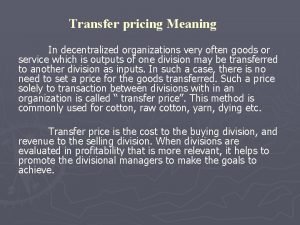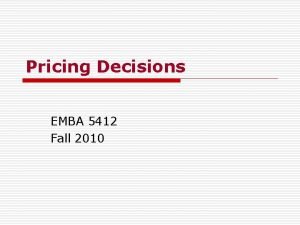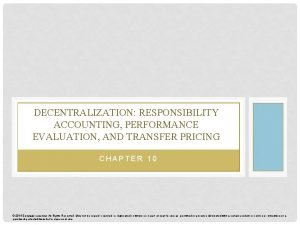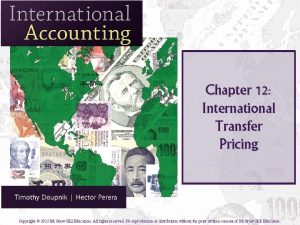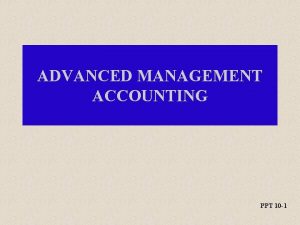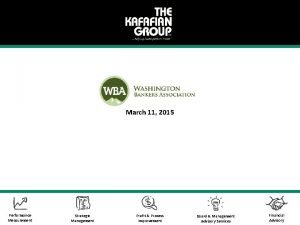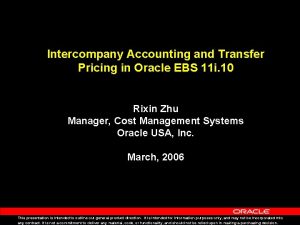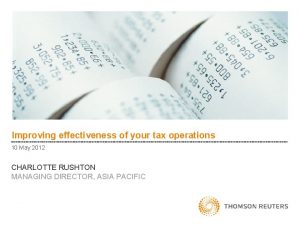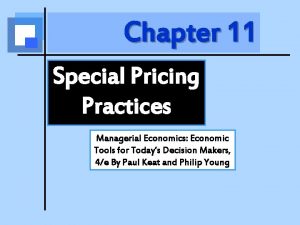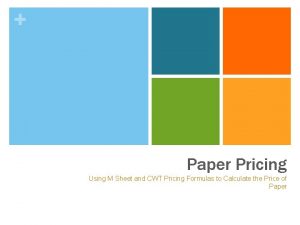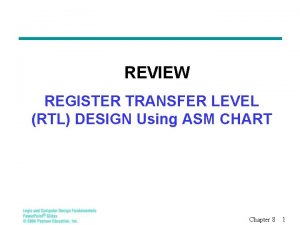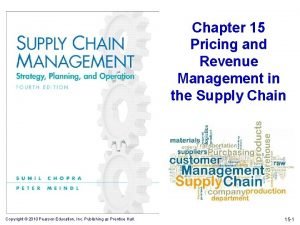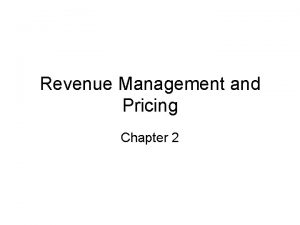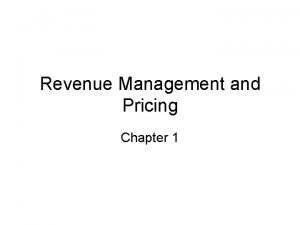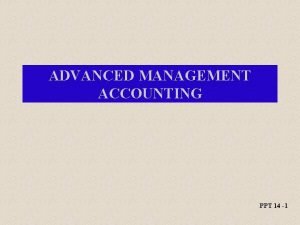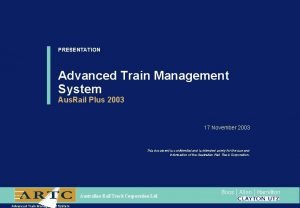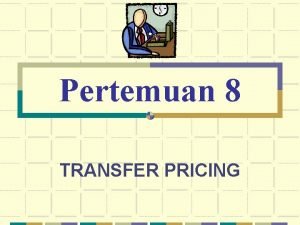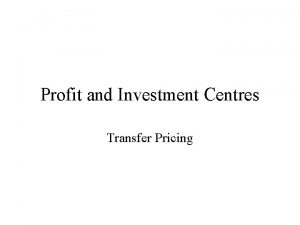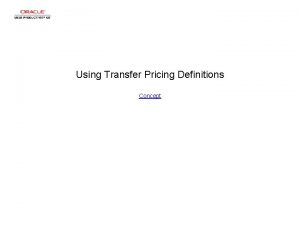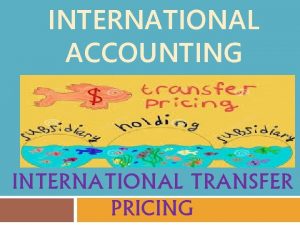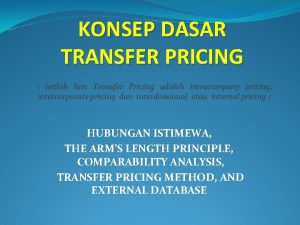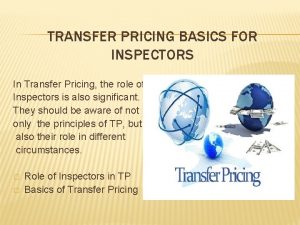Transfer Pricing Management Level Paper P 2 Advanced















































- Slides: 47

Transfer Pricing Management Level – Paper P 2 Advanced Management Accounting Lecture - 19 Vidya Rajawasam ACMA CGMA MBA

Transfer Pricing In the previous lectures we have discussed § Beyond Budgeting Round Table § Six principles of Beyond budgeting § Benefits of Beyond Budgeting

Transfer Pricing In this lecture we will discuss § Transfer pricing § Objectives of transfer pricing § Bases for setting transfer price

Transfer Pricing When a organisation operates with a divisionalized structure – it is likely that one division may supply components or products/ services to another division, in the same company.

Transfer Pricing A key objective of transfer pricing is the fair assessment of performance. The accounts will be distorted where there are significant levels of intra-division/ intracompany trading if transfer pricing isn’t used or if an inappropriate method is adopted. This can lead to incorrect investment decisions and demotivate managers if they think that their division is subsidizing another

Transfer Pricing What is Transfer Price? The transfer price is the price that one division charges another division from the same company for goods or services supplied from one to the other. It is an internal charge – the ‘sale’ of one division is the ‘cost / purchase’ of the other.

Transfer Pricing What is Transfer Price? Although it will be reflected in the results for each division individually, there is no effect in the accounts of the company as a whole. Transfer pricing is needed when an organisation is structured into divisions. And The divisions trade between each other.

Transfer Pricing Example Division A produces goods and transfers them to Division B which packs and sells them to outside customers. Division A has costs of $10 per unit, and Division B has additional costs of $4 p. u. . Division B sells the goods to external customers at a price of $20 p. u.

Transfer Pricing Requirement Assuming a transfer price between the divisions of $12 p. u. , calculate: (a) the profit p. u. made by each division (b) the total profit p. u. made by the company overall

Transfer Pricing Solution (a) the profit p. u. made by each division A B Transfer Price 12 Selling price Cost 10 Transfer Price Costs Profit $2 Profit 20 12 4 $4

Transfer Pricing Solution (b) the total profit p. u. made by the company overall $ $ Selling price 20 Cost - A 10 Cost - B 4 16 Profit 4

Transfer Pricing Explanation Financial performance is assessed for divisions independently –often using profit based measures. Therefore the buying division will wish to minimize costs from purchasing a transferred unit. Whereas the selling division will want to maximize the selling price received.

Transfer Pricing Explanation Furthermore, if we assume that there was no transfer price and goods were transferred ‘free of charge’ between the division, then the overall profit for the company would be unchanged.

Transfer Pricing Explanation However, Division A would only be reporting costs relating to that product, whereas Division B would be reporting an enormous profits ( because they are able to earn sales revenue from an item that is recorded as $0 cost).

Transfer Pricing Explanation The problem would be compounded if Division A was able to sell the same product to an external market - as well as transferring to Division B. Division A will be reluctant to trade with B if all transfers are recorded as a loss making sales.

Transfer Pricing Explanation Therefore a ‘fair’ transfer price is required to record the sale and the costs in the two divisions accounts.

Transfer Pricing Objectives of Transfer Pricing There are three primary objectives of transfer pricing: § Profit maximization § Motivation § Divisional autonomy The three objectives are interrelated and conflicting in nature. Achievement of one objective will inevitably lead to lack of achievement of other objectives.

Transfer Pricing Objectives of Transfer Pricing There are three primary objectives of transfer pricing: § Profit maximization § Motivation § Divisional autonomy The three objectives are interrelated and conflicting in nature. Achievement of one objective will inevitably lead to lack of achievement of other objectives.

Transfer Pricing Objectives of Transfer Pricing Effective transfer pricing should minimize the cost (including interest & tax expense) of goods or services produced by the organization in order to maximize profitability.

Transfer Pricing Objectives of Transfer Pricing Motivation is also likely to be affected by the transfer pricing policy. It is not just short-term profitability of a group, which is important for setting transfer pricing, but also motivation and morale is equally important for the achievement of strategic objectives fluently and efficiently.

Transfer Pricing Objectives of Transfer Pricing Divisional autonomy should not be compromised due to head office intervention in setting of transfer pricing process. Any transfer price should acceptable to selling and buying division as well as organization as a whole. This is technically referred to as ‘Goal Congruence’. Cost minimization and goal congruence achieved by compromising divisional autonomy will lead to de motivation.

Transfer Pricing Review MCQs The objectives of transfer pricing are ? a. Increased motivation among management. b. Provides in depth understanding of direct labour costs. c. Continues performance improvement d. Non of the above

Transfer Pricing Review MCQs The objectives of transfer pricing are ? a. Increased motivation among management. b. Provides in depth understanding of direct labour costs. c. Continues performance improvement d. Non of the above

Transfer Pricing Review MCQs What is true related to Transfer price ? a. b. c. d. It is an internal price mechanism Based on market prices. Based internal costing systems. Non of the above.

Transfer Pricing Review MCQs What is true related to Transfer price ? a. b. c. d. It is an internal price mechanism Based on market prices. Based internal costing systems. Non of the above.

Transfer Pricing Bases for setting transfer price Market based transfer pricing This method appears logical when you think that a firm with a decentralized organizational structure wants each division to act like a standalone entity, with control over all its operations.

Transfer Pricing Bases for setting transfer price Market based transfer pricing If each division were actually a separate company, they would have to buy goods/services on the open market and it makes sense to charge them a market based transfer price.

Transfer Pricing Bases for setting transfer price Market based transfer pricing There a number of difficulties with this method: • Different suppliers in the market quote different prices. • Different buyers ask for different prices (such as a special discount)

Transfer Pricing Bases for setting transfer price Market based transfer pricing There a number of difficulties with this method: • Current market prices can fluctuate so it’s hard to determine a true price The product being transferred may not be available on the open market.

Transfer Pricing Bases for setting transfer price Dual pricing An organisation may choose to use the dual pricing method which is where two transfer prices are recorded. This is an alternative to marginal costing where the selling division has no real incentive to supply the goods internally as they do not make a profit on the transaction.

Transfer Pricing Bases for setting transfer price Dual pricing looks to overcome this situation. The dual pricing system works in the following manner, § The supplying division is credited at a price equal to cost plus a mark up.

Transfer Pricing Bases for setting transfer price Dual pricing The dual pricing system works in the following manner, § The receiving division is debited at marginal cost § The difference is debited to a group account called ‘transfer pricing adjustment account’ and is deducted from group profits at the period end.

Transfer Pricing Bases for setting transfer price Advantages of Dual pricing § The supplying division can record a profit and is incentivized to transfer goods internally § The receiving division gets the goods at the lowest possible price which in turn maximizes group profit (as they’d incur higher costs otherwise).

Transfer Pricing Bases for setting transfer price Advantages of Dual pricing § The supplying division can record a profit and is incentivized to transfer goods internally § The receiving division gets the goods at the lowest possible price which in turn maximizes group profit (as they’d incur higher costs otherwise).

Transfer Pricing Bases for setting transfer price Negotiated transfer prices This is where divisional heads simply agree upon the transfer price themselves. There a few drawbacks to this method though: § Negotiations can be time consuming

Transfer Pricing Bases for setting transfer price Negotiated transfer prices There a few drawbacks to this method though: § Managers may not reach an agreement § One manager may have more experience in negotiating than the other which may lead to a price that favors one division more than another.

Transfer Pricing Bases for setting transfer price Cost Based approach to transfer pricing § Marginal Cost Marginal cost is the cost of producing one more unit. • May be based on variable costs alone or on variable costs plus fixed costs. • Selling division may also add markup.

Transfer Pricing Bases for setting transfer price Cost Based approach to transfer pricing § Marginal Cost § Can result in improper transfer prices causing: – Loss of profitability for company. – Unfair evaluation of division performance.

Transfer Pricing Bases for setting transfer price Cost Based approach to transfer pricing When transfer price is based on cost, it can be actual cost or budgeted cost. The most suitable based would be budgeted cost. § The standard costs or budgeted costs are known to the firm in advance. Therefore, the transfers can be priced as they occur. The selling division can immediately invoice the buying division for all the items transferred.

Transfer Pricing Bases for setting transfer price Cost Based approach to transfer pricing § The actual costs are not known until after the end of the accounting period. Therefore, there will be delays in calculating the pricing of items that will be transferred and their subsequent invoicing.

Transfer Pricing Bases for setting transfer price Cost Based approach to transfer pricing § With standard or budgeted cost based pricing, the manager could be motivated to reduce the costs and improve the profits since he is aware of the budgeted costs.

Transfer Pricing Review MCQs The benefits of dual pricing are ? a. Supports quality assurance programs. b. Identifies the activities and costs related to distribution channels. c. Supplying division can record a profit. d. Improves External supplier relationships

Transfer Pricing Review MCQs The benefits of dual pricing are ? a. Supports quality assurance programs. b. Identifies the activities and costs related to distribution channels. c. Supplying division can record a profit. d. Improves External supplier relationships

Transfer Pricing Review MCQs The cost based approach to transfer pricing ? a. Can be based on actual or budgeted costs. b. Very difficult to implement c. Less threatening to staff d. Cheaper than benchmarking activities.

Transfer Pricing Review MCQs The cost based approach to transfer pricing ? a. Can be based on actual or budgeted costs. b. Very difficult to implement c. Less threatening to staff d. Cheaper than benchmarking activities.

Transfer Pricing Lecture Summary We have discussed the § Transfer pricing § Objectives of transfer pricing § Bases for setting transfer price

Transfer Pricing Management Level – Paper P 2 Advanced Management Accounting Lecture - 19 Vidya Rajawasam ACMA CGMA MBA
 Transfer pricing methods with examples
Transfer pricing methods with examples Transfer pricing example
Transfer pricing example Transfer pricing examples
Transfer pricing examples Types of responsibility accounting
Types of responsibility accounting Transfer pricing example
Transfer pricing example Importance of transfer pricing
Importance of transfer pricing Advanced cost and management accounting ppt
Advanced cost and management accounting ppt Fund transfer pricing
Fund transfer pricing Transfer pricing in managerial economics
Transfer pricing in managerial economics Multi-state transfer pricing analysis
Multi-state transfer pricing analysis Intercompany accounting entries in oracle r12
Intercompany accounting entries in oracle r12 Oecd business restructuring
Oecd business restructuring Transfer pricing
Transfer pricing Global transfer pricing survey
Global transfer pricing survey Wu transfer pricing center
Wu transfer pricing center Pengertian transfer pricing
Pengertian transfer pricing Transfer pricing in managerial economics
Transfer pricing in managerial economics Cwt paper
Cwt paper 4life tf plus advanced
4life tf plus advanced A disturbance in a field that carries energy
A disturbance in a field that carries energy Paper 2 aice general paper
Paper 2 aice general paper Aice general paper exam
Aice general paper exam Trophic level transfer efficiency formula
Trophic level transfer efficiency formula One flip flop per state method
One flip flop per state method Pricing strategies in retail management
Pricing strategies in retail management Role of pricing and revenue management in a supply chain
Role of pricing and revenue management in a supply chain Pricing and revenue management in a supply chain
Pricing and revenue management in a supply chain Price adjustment in retail management
Price adjustment in retail management Pricing decisions and cost management
Pricing decisions and cost management Revenue management and pricing
Revenue management and pricing Revenue management and pricing
Revenue management and pricing Ocr a level computer science paper 1
Ocr a level computer science paper 1 Preparation definition geography
Preparation definition geography Edexcel english literature 2020 paper
Edexcel english literature 2020 paper Aqa psychology a level paper 1
Aqa psychology a level paper 1 Aqa a level chemistry paper 1 2020
Aqa a level chemistry paper 1 2020 Advanced group policy management
Advanced group policy management Advanced farm management program
Advanced farm management program Advance case management
Advance case management Advanced project management and strategic leadership
Advanced project management and strategic leadership Activity based costing ppt
Activity based costing ppt Ao
Ao Advanced certificate management studies
Advanced certificate management studies Advanced train management system
Advanced train management system Advanced principles of fracture management
Advanced principles of fracture management Advanced system management
Advanced system management Advanced fms & security services pvt ltd
Advanced fms & security services pvt ltd Bcadm
Bcadm
